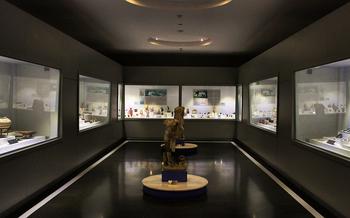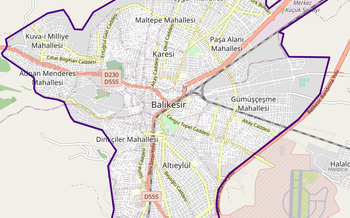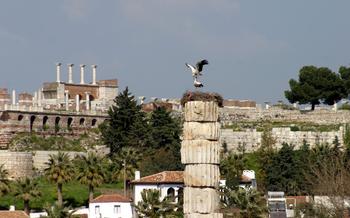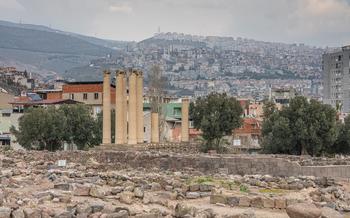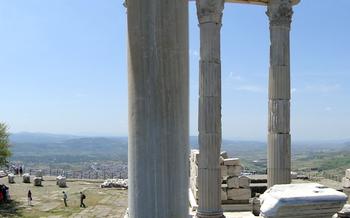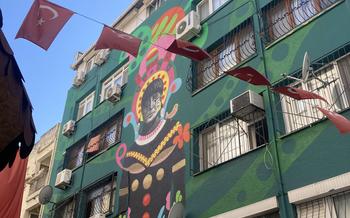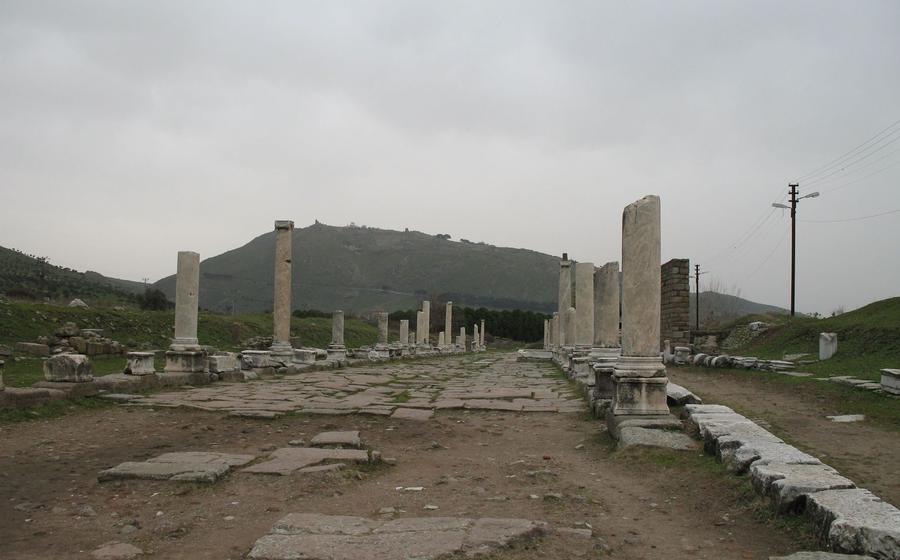
Pergamon Asklepion
- Historical Significance:
- Location:
- Architecture and Design
- Healing Practices at the Pergamon Asklepion
- The Sacred Way: A Path of Healing and Devotion
- Theater
- Healing Deities
- Votive Offerings
- Museum
- Excavations
- Natural Beauty
- Festivals and Events
- Accommodations and Dining:
- Insider Tip:
Historical Significance:
In the ancient city of Pergamon, nestled amidst the fertile plains of Western Turkey, lies a remarkable testament to the power of healing – the Pergamon Asklepion. Dedicated to Asclepius, the Greek god of medicine, this awe-inspiring sanctuary served as a beacon of hope for those seeking relief from ailments and maladies. As one of the most renowned healing centers in the ancient world, the Asklepion attracted pilgrims from far and wide, drawn to its sacred springs, skilled physicians, and the divine presence of Asclepius himself. Within its hallowed halls, the art of healing transcended mere physical remedies, embracing a holistic approach that intertwined spirituality, nature, and medicine. Prepare to be transported back in time as we delve into the fascinating history and enduring legacy of the Pergamon Asklepion.
Location:
The Pergamon Asklepion is situated approximately 25 kilometers north of modern-day Bergama and 100 kilometers north of Izmir, Turkey's third-largest city. It is easily accessible by various means of transportation. To reach the site, visitors can take a scenic bus ride from Izmir or Bergama, offering breathtaking views of the surrounding countryside. Alternatively, renting a car provides the flexibility to explore the region at your own pace. Follow the signs leading to the ancient city of Pergamon, and once you reach the site, the Asklepion is well-marked and easily accessible on foot.
Architecture and Design
The Pergamon Asklepion stands as a testament to ancient architectural ingenuity. Its sprawling complex encompasses several terraces, each serving a distinct purpose. The lower terraces feature a gymnasium, a palaestra for athletic training, and a series of baths, reflecting the importance of physical well-being in the healing process. Ascending the terraces, visitors encounter the stoas, long colonnaded walkways that provided shelter from the elements and served as gathering places for patients and visitors. These stoas are adorned with intricate carvings and sculptures, depicting scenes from Greek mythology and the life of Asclepius.
At the heart of the Asklepion lies the renowned Library of Galen, a treasure trove of medical knowledge and wisdom. This library housed an extensive collection of scrolls and manuscripts on various medical subjects, attracting scholars and physicians from across the ancient world. The library's impressive architecture, with its vaulted ceilings and rows of shelves, reflects its significance as a center of learning and research.
Healing Practices at the Pergamon Asklepion
The Pergamon Asklepion was not merely a place of worship; it was a vibrant center of healing and rejuvenation. Visitors seeking relief from ailments or hoping to enhance their well-being flocked to the sanctuary, where they could avail of various healing practices.
Dream Interpretation: Dreaming was considered a divine means of communication, and the Asklepion provided a sacred space for individuals to seek guidance from the gods through their dreams. Devotees would sleep in the dormitories known as the enkoimeteria, seeking divine revelations or insights into their health and future.
Hydrotherapy: Water played a crucial role in the healing process at the Asklepion. The sanctuary possessed several pools and fountains, each dedicated to a specific deity. Bathing in these sacred waters was believed to possess therapeutic properties, promoting purification and healing.
Sacred Springs: The Asklepion was blessed with an abundance of sacred springs, each attributed with unique healing properties. Devotees would drink from these springs, believing that their waters held the power to cure various ailments and restore vitality.
Incubation: Incubation was a widespread practice at the Asklepion. Individuals seeking healing would spend the night within the sacred precincts, hoping to receive divine guidance or healing dreams. During their incubation, they would abstain from food and engage in purification rituals.
Offerings and Sacrifices: Devotees expressed their gratitude for answered prayers or sought divine favor by offering votive gifts to the healing deities. These offerings ranged from small figurines and coins to elaborate sculptures and precious objects, reflecting the deep faith and devotion of the pilgrims.
The Sacred Way: A Path of Healing and Devotion
As you approach the Pergamon Asklepion, your journey begins along the Sacred Way, a processional path that leads you to the heart of the healing sanctuary. This ancient path is lined with votive offerings and statues of deities, creating a sacred atmosphere that prepares your mind and spirit for the healing experience that awaits.
The Sacred Way is not just a physical path but a symbolic one, representing the journey towards healing and spiritual renewal. As you walk along its ancient stones, you can imagine the countless pilgrims who have tread the same path before you, seeking solace and divine intervention.
The votive offerings that adorn the Sacred Way are a testament to the faith and gratitude of those who have been touched by the healing power of the Asklepion. These offerings, often in the form of body parts or small sculptures, represent the specific ailments that pilgrims sought relief from.
The statues of deities along the Sacred Way serve as reminders of the divine presence that pervades the Asklepion. These deities, including Asclepius, Hygieia, and Telesphorus, represent different aspects of healing and well-being, offering hope and guidance to those who seek their assistance.
Walking the Sacred Way is a deeply immersive experience that transports you back in time to the days when the Asklepion was a thriving center of healing and devotion. It is a journey that prepares your mind and spirit for the transformative experience that awaits you within the sanctuary walls.
Theater
Within the Asklepion complex, visitors can explore a well-preserved theater that played a significant role in the healing practices and religious rituals of ancient Pergamon. Constructed in the 2nd century BC, the theater served as a venue for various performances, including plays, concerts, and recitals. These performances were believed to have therapeutic effects, as they provided entertainment and distraction for patients seeking healing.
The theater's impressive architecture reflects the importance placed on the arts and healing in ancient Greek culture. With a seating capacity of approximately 3,500 spectators, the theater features a large, circular orchestra, a stage building adorned with intricate carvings, and tiered seating sections that offer panoramic views of the surrounding landscape.
During religious festivals and celebrations, the theater was transformed into a sacred space where rituals and ceremonies were held in honor of Asclepius and other healing deities. Devotees gathered to witness performances that depicted stories of healing and divine intervention, seeking inspiration and solace in their own journeys toward health and well-being.
Healing Deities
In addition to Asclepius, the Asklepion of Pergamon was also home to other healing deities who played significant roles in the healing process. Hygieia, the daughter of Asclepius, was the goddess of health, cleanliness, and sanitation. Her presence at the Asklepion emphasized the importance of preventive measures and maintaining good health. Telesphorus, the grandson of Asclepius, was the god of convalescence and recovery. His association with the Asklepion symbolized the hope and support offered to those seeking healing and restoration.
These deities, along with Asclepius, formed a divine triad that represented the comprehensive approach to healing at the Asklepion. Their combined powers and attributes provided a holistic approach to healthcare, encompassing physical, mental, and spiritual well-being.
Votive Offerings
A distinctive feature of the Pergamon Asklepion is the abundance of votive offerings discovered at the site. These offerings, left by pilgrims seeking healing or expressing gratitude for answered prayers, provide valuable insights into the religious practices and beliefs of the ancient Greeks.
The votive offerings found at the Asklepion are diverse, ranging from small clay figurines and amulets to elaborate marble sculptures and inscriptions. Many of these offerings depict body parts, such as eyes, ears, or limbs, representing the specific ailments for which healing was sought. Other offerings include representations of animals, such as snakes, which were associated with Asclepius, or symbols of health and well-being, such as olive branches or pomegranates.
The sheer number and variety of votive offerings at the Asklepion attest to the widespread belief in the healing powers of the sanctuary. These offerings not only provide a glimpse into the personal stories of those who sought solace and healing at the Asklepion but also serve as a testament to the enduring legacy of this ancient site.
Museum
A visit to the on-site museum at the Pergamon Asklepion is a must for anyone interested in the history of medicine and archaeology. The museum houses a fascinating collection of artifacts, sculptures, and medical instruments that provide a glimpse into the ancient healing practices performed at the Asklepion.
Among the highlights of the museum's collection are a series of votive offerings left by pilgrims seeking healing or expressing gratitude for answered prayers. These offerings include anatomical sculptures, stelae with inscriptions describing illnesses and cures, and miniature replicas of body parts.
The museum also displays a collection of surgical instruments, including scalpels, forceps, and probes, which were used by the Asklepion's physicians to perform surgeries and treat injuries. These instruments are remarkably well-preserved and provide valuable insights into the state of medical knowledge in ancient Greece.
In addition to the artifacts and instruments, the museum also features a number of exhibits that explain the history of the Asklepion and the healing practices that took place there. These exhibits are informative and engaging, and they help visitors to understand the significance of this ancient healing center.
Excavations
Archaeological excavations at the Pergamon Asklepion are ongoing and continue to yield new discoveries, shedding light on the site's rich history and medical practices. These excavations have uncovered numerous artifacts, including medical instruments, votive offerings, and inscriptions, which have provided valuable insights into the daily life and healing practices at the Asklepion. One of the most significant discoveries was the remains of a large hospital complex, which included operating rooms, patient wards, and a pharmacy. These findings have helped scholars understand the advanced medical knowledge and surgical techniques employed by the ancient Greeks.
The ongoing excavations at the Pergamon Asklepion are of great importance, as they help us better understand the development of medicine in the ancient world and the role of Asklepios and his sanctuaries in the healing process. By uncovering new evidence and artifacts, archaeologists are piecing together the complex history of the Asklepion and its profound impact on ancient Greek society.
Natural Beauty
The Pergamon Asklepion is blessed with a picturesque natural setting that complements its historical significance. Nestled amidst lush greenery, the site offers breathtaking views of the surrounding countryside. Visitors can stroll through the verdant gardens, admire the colorful flora, and enjoy the tranquility of the natural surroundings. The Asklepion's location on a hillside provides panoramic vistas of the fertile plains below, creating a serene and restorative atmosphere that enhances the healing experience. Whether seeking solace, inspiration, or a deeper connection with nature, the Asklepion's natural beauty provides a sanctuary for visitors to rejuvenate and find inner peace.
Festivals and Events
The Pergamon Asklepion and the nearby town of Bergama play host to several festivals and events throughout the year that celebrate the site's historical and cultural significance. One of the most notable events is the Bergama International Opera and Ballet Festival, held annually in July and August. This prestigious festival showcases world-renowned opera and ballet performances in the enchanting setting of the ancient theater within the Asklepion complex.
Another popular event is the Bergama Kültür ve Sanat Festivali (Bergama Culture and Arts Festival), held in September. This vibrant festival features a variety of cultural performances, exhibitions, traditional crafts demonstrations, and local delicacies, offering visitors a chance to immerse themselves in the rich heritage of the region.
Accommodations and Dining:
For a comfortable stay near the Pergamon Asklepion, consider the charming hotels and guesthouses in the town of Bergama. These accommodations offer a range of options to suit different budgets and preferences, from cozy family-run establishments to modern hotels with amenities.
Complement your visit with a culinary adventure by savoring the delectable local cuisine. Bergama's restaurants serve traditional Turkish dishes prepared with fresh, seasonal ingredients. Indulge in succulent grilled meats, flavorful kebabs, and tantalizing mezze platters, accompanied by the region's renowned olive oil and locally produced wines.
To immerse yourself fully in the local culture, venture beyond the main tourist areas and explore the hidden culinary gems of Bergama. Discover small, family-owned restaurants tucked away in side streets, where you can enjoy authentic home-cooked meals and engage with the friendly locals.
Whether you prefer a quick bite or a leisurely dining experience, Bergama offers a diverse range of culinary delights to satisfy every palate. From traditional Turkish fare to international cuisine, there's something for everyone to savor in this vibrant town.
Insider Tip:
- To fully appreciate the serenity and grandeur of the Pergamon Asklepion, consider visiting early in the morning or late in the afternoon when the crowds are fewer. The golden hues of sunrise and sunset cast a magical glow on the ancient ruins, creating a truly unforgettable experience. Additionally, guided tours in various languages are available for those who wish to delve deeper into the history and significance of the site. Be sure to inquire about tour availability upon arrival.
